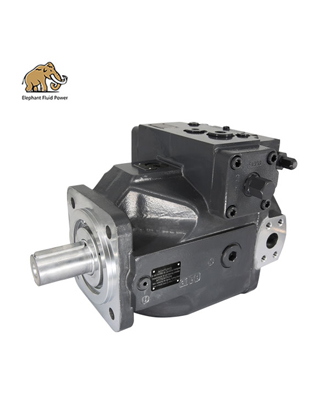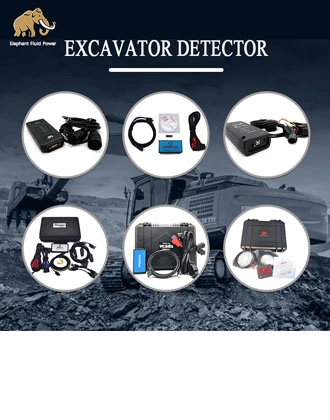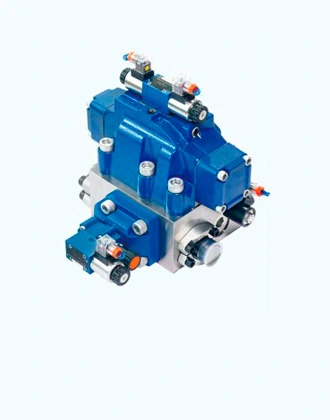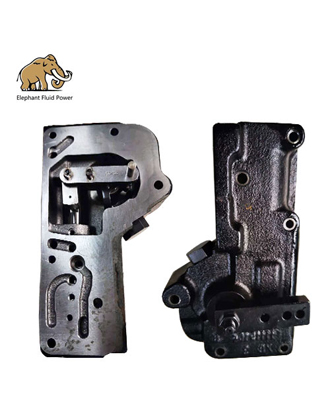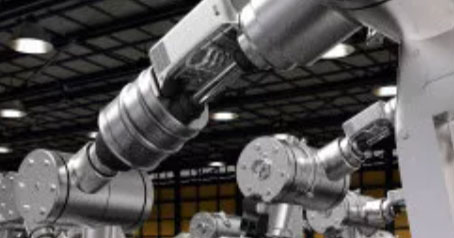Ⅰ. The hydraulic pump connection precautions
1. The hydraulic pump can be installed with bearings or flanges. The pump and the prime mover should use a shared base bearing, and the flange and foundation should have sufficient rigidity. Special attention: Piston pumps with a flow rate greater than (or equal to) 160L/min should not be installed on the oil tank.
2. An elastic coupling should be used to connect the hydraulic pump and the output shaft of the prime mover. It is strictly forbidden to install a pulley or a gear-driven hydraulic pump on the hydraulic pump shaft. If a pulley or a gear must be used to connect the pump, a pair of support seats should be installed When the pulley or gear is used, the coaxiality error between the bearing and the pump shaft should not be greater than Φ0.05mm.
3. The suction pipe should be as short as possible. Straight, large and coarse, the oil suction pipeline generally needs to be equipped with a coarse filter whose nominal flow is not less than twice the pump flow (the filtration accuracy is generally 80 to 180 μm). The oil drain pipe of the hydraulic pump should be directly connected to the oil tank, and the back pressure of the oil return should not be greater than 0.05MPa. The oil pump suction pipe port and the oil return pipe port are required to be 200mm below the minimum oil level of the oil tank.
4. The inlet and outlet of the hydraulic pump should be firmly installed, and the sealing device should be reliable, otherwise there will be air intake or oil leakage, which will affect the performance of the hydraulic pump.
5. The self-priming height of the hydraulic pump should not exceed 500mm (or the inlet vacuum should not exceed 0.03MPa). If the oil of the charge pump is used, the oil pressure should not exceed 0.5MPa. When the oil pressure exceeds 0.5MPa, a pressure sealing ring should be used. For plunger pumps, self-priming should be used as much as possible.
6. Before installing the hydraulic pump installation hole, check whether the depth of the shaft is greater than the length of the pump to prevent the phenomenon of jacking the shaft, otherwise the pump will be burned out.
Ⅱ. Precautions for the use of hydraulic pumps
1. Start the hydraulic pump and move it several times first, the oil flow direction and sound are normal, run at low pressure for 5 to 10 minutes, and then put it into normal operation. Before starting the plunger pump, the pump must be filled with clean working oil through the oil discharge port on the pump casing.
2. The viscosity of the oil is affected by the temperature change. The oil temperature increases and the viscosity decreases, so the oil temperature is required to be kept below 60 °C. In order to make the hydraulic pump work stably at different working temperatures, the selected oil should have a viscosity that is affected by the oil temperature change. Smaller characteristics, as well as better chemical stability and anti-foaming properties.
3. The oil must be clean, and must not be mixed with mechanical impurities and corrosive substances. The oil suction line has no filter device hydraulic system, and must be filtered by an oil truck (filtering accuracy less than 25μm) to the fuel tank.
4. The maximum pressure and maximum speed of the hydraulic pump refer to the allowable peak use in a short period of time. Long-term use should be avoided, otherwise the service life of the pump will be affected.
5. The normal working temperature of the hydraulic pump is 15°C to 65°C, and the maximum temperature on the pump casing is 10°C to 20°C higher than the oil temperature at the pump inlet. When the oil temperature reaches 65°C, the maximum temperature does not exceed 75°C to 85°C.
 French
French
 Portuguese
Portuguese
 Russian
Russian
 German
German
 Spanish
Spanish
 Japanese
Japanese
 Korean
Korean
 Irish
Irish
 Greek
Greek
 Turkish
Turkish
 Italian
Italian
 Danish
Danish
 Romanian
Romanian
 Indonesian
Indonesian
 Czech
Czech
 Afrikaans
Afrikaans
 Swedish
Swedish
 Polish
Polish
 Basque
Basque
 Catalan
Catalan
 Esperanto
Esperanto
 Hindi
Hindi
 Lao
Lao
 Albanian
Albanian
 Amharic
Amharic
 Armenian
Armenian
 Azerbaijani
Azerbaijani
 Belarusian
Belarusian
 Bengali
Bengali
 Bosnian
Bosnian
 Bulgarian
Bulgarian
 Cebuano
Cebuano
 Chichewa
Chichewa
 Corsican
Corsican
 Croatian
Croatian
 Dutch
Dutch
 Estonian
Estonian
 Filipino
Filipino
 Finnish
Finnish
 Frisian
Frisian
 Galician
Galician
 Georgian
Georgian
 Gujarati
Gujarati
 Haitian
Haitian
 Hausa
Hausa
 Hawaiian
Hawaiian
 Hebrew
Hebrew
 Hmong
Hmong
 Hungarian
Hungarian
 Icelandic
Icelandic
 Igbo
Igbo
 Javanese
Javanese
 Kannada
Kannada
 Kazakh
Kazakh
 Khmer
Khmer
 Kurdish
Kurdish
 Kyrgyz
Kyrgyz
 Latin
Latin
 Latvian
Latvian
 Lithuanian
Lithuanian
 Luxembourg
Luxembourg
 Macedoniar
Macedoniar
 Malagasy
Malagasy
 Malay
Malay
 Malayalam
Malayalam
 Maltese
Maltese
 Maori
Maori
 Marathi
Marathi
 Mongolian
Mongolian
 Burmese
Burmese
 Nepali
Nepali
 Norwegian
Norwegian
 Pashto
Pashto
 Persian
Persian
 Punjabi
Punjabi
 Serbian
Serbian
 Sesotho
Sesotho
 Sinhala
Sinhala
 Slovak
Slovak
 Slovenian
Slovenian
 Somali
Somali
 Samoan
Samoan
 Scots Gaelic
Scots Gaelic
 Shona
Shona
 Sindhi
Sindhi
 Sundanese
Sundanese
 Swahili
Swahili
 Tajik
Tajik
 Tamil
Tamil
 Telugu
Telugu
 Thai
Thai
 Ukrainian
Ukrainian
 Urdu
Urdu
 Uzbek
Uzbek
 Vietnamese
Vietnamese
 Welsh
Welsh
 Xhosa
Xhosa
 Yiddish
Yiddish
 Yoruba
Yoruba
 Zulu
Zulu

